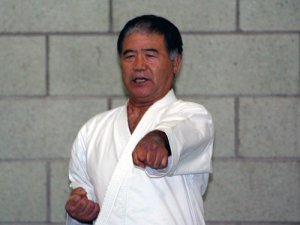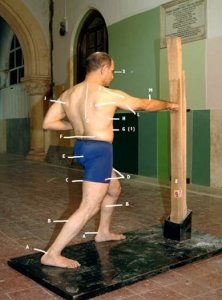Anatomy of a Punch
By: Sensei Pervez Mistry – IOGKF India
(From December 2012 IOGKF International Newsletter)
INTRODUCTION
On returning from The Okinawa Budosai in 2004 one of my students, a Go-Kyu from our Honbu dojo, wrote a very interesting article, entitled “THE SCIENCE OF STANDING PROPERLY”, and which was published in our old International Newsletter.
There is always something to learn from everyone and everything around you, be it your Sensei, or student. Kersi’s article sparked off a dormant interest on this topic, that went off like a delayed time bomb and had me hunting for my old notes, pen and paper
During my research on “Sanchin Kata”, with Dr. Doongajee, head of the research wing of the KEM Hospital, I had done a rough draft on the speed and power of a punch, based on experiments we had done. Now thanks to Kersi, I am finally completing what I had begun many years ago.
“A punch is just a punch and a kick is just a kick”.
– Bruce Lee.
OR IS IT?
PHYSICS OF A PUNCH
Before delving into the physiological aspects of a punch, let us first understand the Physics behind this simple but highly effective technique.
Many years ago I had read an article in “Scientific America”, called “Karate Physics”, and now on searching through the net, I came across several such studies from various Universities and research organizations from around the world. Most of these studies are based on finding out the exact speed and power of a punch and in some cases a kick, as well as a downward strike( I dislike the word chop in this context), or Shuto Uchi, applied in board or brick breaking.
To determine the speed and impact force some researchers now a days use laser technology, but others use strobe lights at 60 and 120 pulses per second. The karate-kas at various levels of proficiency performed innumerable punches which were photographed. On developing the film, the speed of the punch was calculated by counting the number of times the strobe flashed until the fist hit the target.
It was found that students with up to a year of training had an average speed of 20 feet per second, or a bit more than 6 meters per second. The Black Belts with more than five years of training clocked in at 46 feet per second, or about 15 meters p/s. Finally the Black Belts with more than 20 years, did an astonishing 76 feet per second. In everyday terms that’s precisely 69.4736842105 miles per hour.
Now take into consideration that the weight of an average human hand weighs in at 1.1/2 lb., the force of impact ranged from 800 newtons (one Newton = 0.2248 lb per sq. inch, or to put it more imaginatively, is approximately equal to the force exerted by the weight of an apple), to 17,500 newtons or an amazing 3,934lb per sq. inch. It requires only 1,900 or 427 lb per sq. inch to go through a concrete block.
Boxers too can punch as quickly and have an impact force as strong as any Karateka, but they do not break any concrete blocks, or a pile of bricks. The difference is in the technique or nature of their punch. When a boxer punches he normally ends the movement with a follow through – just as golfers and tennis players do – and it will surely knock down his opponent. But in fact, this follow through puts the brakes on the actual point of impact, and thereby diffusing the force of the blow. In boxing the idea is to jar the opponent not to smash the bridge of his nose and send the bone into his brain.
A karate Oi-zuki (lunge punch), or a Gyaku-zuki (reverse punch), has no follow through. The zuki strikes out like a cobra, and withdraws instantly. It was found that when a fist strikes a 2.5 inch thick board, the time of contact is a mere 5 milliseconds, and yet the board breaks with a resounding crack.
How does this work? We found out that as a Oi-zuki when correct form is executed, it reaches maximum velocity when the arm is about 80% extended. This is precisely what we have been taught. We learn to focus in such a way that the punch ends inside the opponents body rather than on the surface. To deliver maximum power the contact has to be made before the slow down begins.
There is an old saying in Japanese, which translates to “One punch, one life”. We train in Karate not as a sport, but to defend ourselves and others, when there is no other option available. It may be brutal, but it is a fact of life. When a hundredth of a second is all that may save you from a deadly knife attack, you have to garner all your resources that the training has given you. For this reason alone, Makiwara training is absolutely necessary.
In “Tameshi wara” or breaking techniques it is important to know and understand the suttle forces at work. All inanimate objects, solid as they may seem, have a minimum elastic limit. Hit an object with enough force and they begin to vibrate, and when this vibration reaches its elastic limit, the object begins to give way and finally breaks.
Now the question that you may be thinking of, is with all this power and impact force, how come the knuckles of your hand or the bones on the ball of your feet don’t break.
It has been found that bone can take 40 times more force than a concrete block, and your center finger bone can take a force greater that 25,000 Newtons or 5,620lb per sq. inch.
Furthermore, regular Makiwara practice puts on layers of tough callous on the contacting surfaces of your hands and feet, resulting in far greater protection.
PHYSIOLOGY OF A PUNCH
MENTAL
The brain and the body together have made us the most formidable species on this planet. As the noted author Bill Bryson said in his recent book “Ä short History of nearly Everything”, has put it so aptly, “It’s an unnerving thought that we may be the living universe’s supreme achievement and its worst nightmare simultaneously”.
The brain houses the mind, which in turn comprises of the volatile mixture of emotional and logical thinking processes. Playing a game of chess involves the logical mind, while playing a game of Table Tennis uses the instinctive reflexes brought about through the emotional mind, which allows the body to react instantaneously to the ever changing responses of the game. The body then sets into a rhythm, and if the tempo of this rhythm is correct, it increases the fluidity in the body to enable the player to react much faster than his opponent.
The very instant your eyes perceive an opening in your opponent’s defense, your control switch board or the nervous system goes into hyper drive. Your eyes are your body’s primary organ for the assessment of all that is happening around you, and it is for this reason that you must learn to use your peripheral vision, which works far better than using focused vision, during fast bodily movement. Messages from the Ophthalmic centre are relayed through the spinal cord to the nerve centers in all the muscles of the body. Some muscles contract, and others lengthen, still others stabilize and control the body all at the same time. This complex wizardry happens thanks to the sympathetic and parasympathetic branches of the nervous system. Whilst the former operates from the cervical, thoracic and lumbar vertebra, the latter operates from the top of the spinal column namely the Atlas and at the lower end of the vertebral column, the Sacrum vertebra. If the muscles around the spinal column are normally tensed either through bad posture, injury, or poor technique, the free-flow of messages and the speed of transfer will be curtailed to a marked extent, resulting in poor performance.
Our mind and body combines the “Holy Trinity” that makes each one of us what we are. The integration of the mental, emotional and physical all combining together gives us the fulfillment of thinking, feeling and being.
Our mental faculties comes from the head within which lies the brain, and is thanks to the chemical and electrical communication between the millions of brain cells that sensory information is gathered, analyzed and assimilated.
Our feelings that are the basis of our emotions literally and figuratively come from the heart. During times of extreme happiness or extreme sadness, we literally feel our heart stop and re-start, or even race along. This comes from the electrical impulses given by the sinoatrial node(SA) also called the natural peace-maker . When we become emotional our endocrine system secretes hormones, which in turn affects the SA node, giving us the feeling of extreme depression or happiness. Martial Art training gives the practitioners control of their emotional content, anger is channeled into focus, fear into cautiousness and pride into compassion. Shihan Higaonna on one of his trips to India, had
presented me with his work of Japanese Calligraphy, which says “FUDOSHIN”, and when I asked him what it meant, he said in his inimitable style “Poker Face”.
Our physical strength is located an inch below the naval, and is also the center of gravity of the body. It is at this location that gives us our sense of being. It is the source of our “gut feelings”, that keeps our honesty and morality on an even keel.
PHYSICAL
In order to understand how the body works at the execution of a punch, it is important to know the types of muscles doing the work:
Agonist muscles: These are the muscles that contract and shorten and do the actual work.
Antagonist muscles: These muscles work in tandem with the Agonist muscles simultaneously. While the Agonist muscles contract Antagonist muscles lengthen. For example on doing a bicep curl, the bicep muscle shortens or contracts , and at the same time the triceps muscle lengthens, enabling you to lift the lower arm upwards.
Fixators & Synergists: These muscles help to support and hold the body together. Using the above example, the scapularis (shoulder blade) and pectorals(chest ) muscles act to hold the arm in place. All action that requires movement of the body is essentially a combining force of muscle contraction and relaxation around the joints.
EXECUTION
At the point of delivering a right Gyaku-zuki, here is what happens in less time than it takes you to blink.
In the half Zenkutsu-dachi or forward stance, the shin muscles act as synergists to hold the feet and ankle joints, with the spring energy of the Achilles tendon, to snap and power the whole body into action.
Now the Quadriceps muscles along with the large Gluteus muscles of the butt, work as Agonists to accelerate the knee and hip joint sending power up the leg.
The Transverse muscle or the deep abdominal corset, and the Erector spinae or lower back muscles now work as synergists and antagonist to stabilize the pelvis and spine, and simultaneously the upper back muscles are working as agonists to further speed up the torquing action of the torso, delivering power up the body.
At this point of time, the thoracic rib cage opens out like a bow and the agonists muscles of the lats and chest alongwith theDeltoid muscles of the shoulder power the arm muscles; the triceps, biceps and the extensors of the fore-arm, like an arrow, for a powerful delivery of the gyaku-zuki.
Hang on there, its not quite over yet.
Whilst this complicated sequence is going on, other muscles work to control and stabilize parts of the body in order to recover quickly. As the Soleus and Gastrinomous muscles of the calves contract isometrically, the muscles at the back of the thighs or hamstrings, lengthen to hold and control the knee joints. As the pelvic and torso twists upwards, the muscles on the right and left sides of the body, the Psoas muscles also referred to as the Suspender muscles, or the lateral and anterior link between the spine and the upper thigh, lengthen to control the pelvis.
The Rhomboid muscles and the Rotator Cuff muscles of the upper back and shoulder, work to stabilize to control the shoulder joint, so that the arm can be extended with blinding speed and awesome power, and immediately return to an on-guard or Kamae position, ready for defense or attack.
Martial Artists have known for a very long time that core power generates from the low abdominal region, which has now been substantiated by sports scientists and researchers. However, from the above explanation it becomes abundantly clear that all body activity is a result due to the ‘Kinetic’ muscle chain that unites all parts of the body for total body power. Consequently if there is any weak unit in the muscle chain, it will result correspondingly in a reduction of speed and power.
For example; if a Karateka has a tight Hamstring muscle, it will curtail the amount of twisting action on the trunk, which in turn will disrupt free flow of forces up the back and into the shoulder and punching arm. The muscle mass of the shoulder is relatively small and if inadequate power is generated by the preceding links in the Kinetic muscle chain, the shoulder has to increase and generate power, instead of being the force regulator it is. Hence by steadily increasing the flexibility of the hamstring muscle at the back of the thigh, lumbar strength and trunk rotation during a gyaku-zuki will greatly reduce the incidence of rotator-cuff injury, in the shoulder. Though this diagnosis of biomechanical analysis is difficult, with study and knowledge of human anatomy, is a crucial and effective element in preventing an injury especially in the high risk prone shoulder joint.
Well, there you have the Anatomy of a punch, so the next time your Sensei tells you “More Ichido”, after the first hundred repetitions of gyaku-zuki, perhaps you will have a greater appreciation and understanding of the technique and yourself in totality.
Figure: 1. MUSCULATURE DURING & AT COMPLETION OF STRIKE.
A: Achilles Tendon Giving the spring Elastic energy from the ground, and driving power up the legs..
B: Calf muscles. Lengthening on the back leg in an isometric contraction, with concentric contraction on the front leg.
C: Hamstrings: Lengthen to stabilize the knee and pelvic joints.
D: Quadriceps: Contracting to add power to the pelvic and lower abdomen; the Power Center.(1).
E: Gluteus: Contract to speed up power into the Power Center (1).
F: The External and Internal Obloquies muscles , which assist in torquing the pelvis,
Accelerating the movement.
G: The Lower Abdomen, which includes the Strength & Power Center (1) and the anterior Abdominal muscles.
H (2): From the Abdominal muscles the power moves upwards into the lower back and
Into the Thoracic Center (2), which opens outward enhancing power into the large
Lat muscles H.
I: For every action there is an equal and opposite reaction; Newton’s third Law of motion
Is very aptly applied here. The greater the pull back the faster and stronger the zuki.
J, K, L, M: The agonists muscles of the Scapularis and the Rotator Cuff J , now
contract sending power into the Deltoids K, and the Triceps L, further powering the extensor muscles of the fore-arm, culminating through the first two knuckles of the punching fist.
Acknowledgements:
Barbara Conable. :”How to Learn the Alexandra Techniques”.
Lee Parore: “Power Posture”.
Bill Bryson : Ä short History of nearly Everything”
Shoulder Injuries prevention & treatment. Published by “Peak Performance”.
Word Count: 2,608.
© Pervez B. Mistry August 2005.


